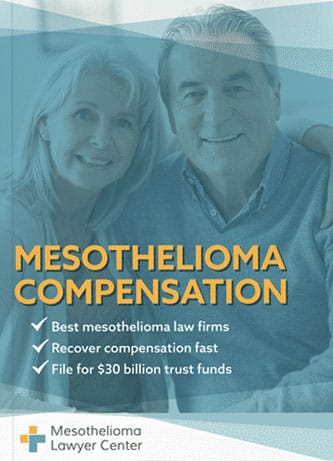Honeywell Heating Specialty Co. began manufacturing water heaters more than 100 years ago. The acquisition of refractory companies that used asbestos led to asbestos liability and lawsuits. Honeywell eventually filed for bankruptcy and established an asbestos trust fund.
Si padece mesotelioma, cáncer de pulmón relacionado con el asbesto o asbestosis, podría tener derecho a una indemnización considerable. Actualmente, existen más de 1.400 millones de dólares en fondos fiduciarios para el asbesto creados para quienes han sido diagnosticados con una enfermedad relacionada con el asbesto. FComplete nuestro formulario para obtener un Paquete de Compensación Financiera gratuito. Aprenderá sobre los abogados con experiencia en mesotelioma en su área, cómo recibir su pago en 90 días, cómo presentar una reclamación a los fondos fiduciarios de asbesto y más.


Paquete de compensación financiera GRATUITO
- Información sobre despachos de abogados que recuperarán su INDEMNIZACIÓN MÁS ALTA
- Aprenda cómo cobrar en 90 días
- Solicite su parte de $30 mil millones en fondos fiduciarios

Did Honeywell Use Asbestos?
Honeywell has faced billions of dollars in liabilities for asbestos exposure and resulting illnesses. The liabilities come from companies that it acquired. Honeywell subsidiaries AlliedSignal, NARCO, and Bendix used asbestos in their operations and to make products.
History of Honeywell International
Honeywell traces its corporate roots to 1885, when a Swiss immigrant and businessman named Albert Butz invented the damper flapper, an early version of the modern thermostat.
- In 1886, Butz founded the Butz Thermo-electric Regulator Company. After various changes, mergers, and restructurings, Butz’s enterprise became the Minneapolis Heat Regulator Company.
- Meanwhile, Mark Honeywell was developing a heat generator. He founded the Honeywell Heating Speciality Company in 1906 based on his designs.
- In 1927, Honeywell merged with the Minneapolis Heat Regulator Company and renamed it Minneapolis-Honeywell Regulator Company.
- The company became the nation’s biggest maker of high-quality jeweled clocks. As its customer base grew, it expanded its product line to include indicators and various industrial control devices.
- Starting in the 1930s, Minneapolis-Honeywell expanded its operations to serve businesses and consumers internationally. By 1941, the company set up offices in Canada and Europe, as well as distributors in South America, Australia, and Africa.
- Over time, the company survived and thrived by adapting to technological changes, especially after America’s entry into World War II. The war marked Minneapolis-Honeywell’s involvement with the defense industry as a maker of electronic autopilots.
- By the 1960s, when chairman James Binger changed the company name to Honeywell, its military products included landmines, missile guidance systems, and various types of bombs.
- Honeywell also broadened its business across several areas, including computers, photographic equipment, security systems, and the aerospace industry.
- As it expanded its operations, Honeywell merged with three companies, Allied Signal, Inc., NARCO, and Bendix, that used asbestos. Honeywell took on liabilities for past asbestos exposure and resulting illnesses related to these companies.
- The costs of lawsuits led to NARCO’s asbestos trust fund and a new subsidiary called Garrett Motion that held Honeywell’s liabilities.
Today, Honeywell International is a large, worldwide company focusing on research and development and manufacturing in several industries.
How Did Honeywell Use Asbestos?
Honeywell acquired three companies that used asbestos in its products:
- NARCO was a refractory materials company. It made products designed to withstand very high temperatures for workplaces like steel mills and foundries.
- AlliedSignal made friction brake components with asbestos for the automotive industry.
- Bendix came with the acquisition of AlliedSignal and made clutches and brakes with asbestos.
Occupations Affected by Honeywell and Asbestos
Workers in several industries were at risk of exposure to asbestos through Honeywell subsidiary asbestos products. These include workers in high-heat workplaces and automotive manufacturing workers and mechanics.
- Brake installers
- Auto mechanics
- Automotive assembly workers
- trabajadores de la construcción
- Trabajadores de acerías
- Foundry workers
- Shipyard workers
- Instaladores de tuberías
- Machine operators
- U.S. military veterans
Many people serving in the military (mainly the Marina de los EE. UU.) risked exposure to asbestos and developed illnesses because of Honeywell’s products with asbestos. The military was a major consumer of asbestos products.
Honeywell Asbestos Lawsuits
Honeywell and its subsidiaries faced thousands of asbestos lawsuits from exposed workers who developed mesothelioma and other illnesses. These are just a few examples:
- James Phillips handled Bendix asbestos brakes for many years in his work as a mechanic. He died from mesothelioma in 2013. Phillips’s family sued for wrongful death and was awarded $5.8 million by a California jury. Honeywell unsuccessfully appealed the decision.
- Stephen Brown, another auto mechanic, died from mesothelioma in 2000. His widow sued several different companies and won $53.5 million in settlements. Honeywell and Bendix were found to be 2% liable for her damages.
- Yet another mechanic, Ronald Burlie Thomas, died from mesothelioma in 2017. He worked with Bendix asbestos parts. A jury awarded Thomas’s estate and family $18.5 million.
NARCO Bankruptcy and Honeywell Asbestos Trust Fund
Honeywell has never filed for bankruptcy over asbestos lawsuits, but NARCO did. Honeywell also made legal and financial maneuvers to settle its asbestos liabilities.
Honeywell and its subsidiaries took several steps to deal with the high costs of its liabilities and asbestos claims:
- In 2002, the NARCO division filed for bankruptcy. After it emerged from bankruptcy, the division began a reorganization plan. It started formally accepting asbestos trust fund claims on October 15, 2013. At the time, Honeywell stated that it had an estimated $1.1 billion asbestos liability due to NARCO.
- Honeywell dealt with more than 40,000 Bendix asbestos claims by selling the unit to Federal-Mogul in 2003. Federal-Mogul had already filed for bankruptcy in 2002 over its own asbestos liabilities. Honeywell agreed to pay claims for four years with a cap on annual amounts paid into Federal-Mogul’s trust. Ultimately, Honeywell continued to be responsible for Bendix-related asbestos claims.
- In 2019, Honeywell created a subsidiary called Garrett Motion Inc. in 2019. It put its asbestos liabilities into Garrett, which then sued Honeywell for forcing its liabilities on the new company. The U.S. Securities and Exchange Commission investigated and found that Honeywell had underestimated its asbestos liabilities by over $1 billion.
In 2022, Honeywell agreed to pay $1.3 billion to the NARCO trust to end its asbestos liabilities for related claims. Honeywell remains liable for Bendix claims.
If You Were Exposed to Asbestos Through Honeywell
Contact a mesothelioma lawyer if you received a diagnosis after working with Honeywell, NARCO, or Bendix products. They can help you seek compensation.
You could be eligible for a claim with the NARCO Trust. If your exposure came from Bendix, you can still sue Honeywell for damages. A lawyer can help you make the best choice and guide your steps as you get the compensation you need.
Additional Information and Legal Resources for Asbestos Victims
Don’t forget to fill out our form for our free Paquete de compensación financiera, lleno de información sobre los abogados con experiencia en asbesto y mesotelioma en su área. Para obtener ayuda adicional, contáctenos en 800-793-4540.

Pablo Danziger
Revisor y editorPaul Danziger creció en Houston, Texas, y se licenció en Derecho en la Facultad de Derecho de la Universidad Northwestern en Chicago. Durante más de 25 años, se ha dedicado a representar a víctimas de mesotelioma y a otras personas afectadas por la exposición al asbesto. Paul y su bufete han representado a miles de personas diagnosticadas con mesotelioma, asbestosis y cáncer de pulmón, obteniendo indemnizaciones significativas para los clientes lesionados. Cada cliente es fundamental para Paul y atenderá todas las llamadas de quienes deseen hablar con él. Paul y su bufete se encargan de casos de mesotelioma en todo Estados Unidos.
Conéctese con el abogado especializado en mesotelioma Paul Danziger
Referencias
- Honeywell. (n.d.). The History of Honeywell.
Recuperado de: https://www.honeywell.com/us/en/company/our-history - NARCO Asbestos Trust. (n.d.). Welcome to the NARCO Asbestos Trust Home Page.
Recuperado de: http://www.narcoasbestostrust.org/ - Bloomberg Law. (2017, June 16). Honeywell Loses Second Bid to Flip $5.8M Asbestos Verdict.
Recuperado de: https://news.bloomberglaw.com/product-liability-and-toxics-law/honeywell-loses-second-bid-to-flip-58m-asbestos-verdict - Berenson, A. (2002, April 18). Honeywell Say Asbestos Verdict Was More Than it Had Disclosed. The New York Times.
Recuperado de: https://www.nytimes.com/2002/04/18/business/honeywell-says-asbestos-verdict-was-more-than-it-had-disclosed.html?pagewanted=all&src=pm - Satter, L. (2019, January 31). $18.5M Award Over Fatal Asbestos Exposure at Central Arkansas Brake Shop. Arkansas Democrat Gazette.
Recuperado de: https://www.arkansasonline.com/news/2019/jan/31/18-5m-awarded-over-fatal-asbestos-expos/ - Reuters. (2022, November 21). Honeywell to Pay $1.3 Bln to Resolve Asbestos-Related Claims.
Recuperado de: https://www.reuters.com/legal/honeywell-pay-13-bln-resolve-asbestos-related-claims-2022-11-18/
